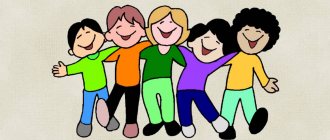It is believed that imitation in the truest sense of the word is the direct copying of someone else's actions, which is a way to learn a new behavioral form.
In a broader sense, imitation is an influence on a person in which he, independently, of his own free will, begins to carry out certain actions, imitating the subject influencing him, who often may have no idea about such an influence on someone. Such cases are called non-directional influence.
By repeating any actions of another person, copying his gestures, actions, character traits, intonation and even facial expressions, a person chooses a role model for himself. Copying behavioral factors can be either voluntary or involuntary. The conscious goal of copying another person in this case will be voluntary imitation, but if you do it without thinking, this is involuntary imitation.
As a result of involuntary actions, the object of influence acquires previously uncharacteristic types of active activity, which are transmitted to him by the subject of imitation. If such activity completely changes a person’s personal categories, the phenomenon of the so-called ideal representation of the subject’s personality in the person being influenced may arise.
Age categories
Depending on the age of a person, there are different periods of imitation. For example, in infancy, a child simply copies external actions, sound reactions of parents and adults, but in later childhood, more complete processing of images received from the outside is carried out.
In the elementary grades of school, imitation of the personal characteristics of adults begins; in high school, peers become the subject of copying behavioral factors. As we grow older, a phenomenon called mutual imitation arises - when a group of people takes the necessary characteristics from each other, so to speak, group imitation. In adolescence, the main role in behavioral imitation is played by the personal qualities of the subject of imitation, his life values, and character.
We recommend: Collectivism and individualism
Based on this, we can trace how the content changes and conclude that at a younger age a person takes an example from adults and adapts to existence in a material world filled with physically accessible things, and at an older age he adopts social models and behavioral clichés. The main role here begins to be played not by external copying of actions, movements, and so on, but by socially significant factors, the habits of the person whom the young man has chosen as an example to follow.
Imitation and its social significance can hardly be overestimated in the light of the individual’s assimilation of specific community experience, which we can divide into several stages of a person’s personal development. No matter how you look at it, the influence of copying as a factor in social development finds a lot of evidence. For example, when an individual is subject to certain social canons and boundaries that are respected by all other members of the social environment, it will be difficult for the person not to comply with them or to act contrary to them.
This behavior can be described as a kind of group human consciousness. A person needs to feel and understand that he is doing everything right, within the social norm. By copying the behavior of the majority, their thinking, actions, even culinary tastes, a person begins to fit in with his surroundings, to feel like “one of his own.” After all, the majority does exactly this, which means it’s right, the person thinks.
In psychology, they highlight the fact that imitation causes a fear of being isolated from everyone else. Every person wants to be like everyone else, not to stand out strikingly for something special that is not accepted in this particular social circle.
Remember, did you want to be in the role of the “black sheep” in kindergarten, at school, at university? It is because of the fear of being “overboard” that a person adopts all the main socially significant behavioral factors - in order to be “like everyone else” in his social group.
Mechanisms of imitation in children aged from birth to 3 years
The imitation mechanism is formed in a newborn baby by about three weeks. The child is trying to imitate the simple motor activity of an adult. From a psychological point of view, the appearance of imitation indicates preparation for imitation through innate reflexes (J. Piaget).
However, it is quite difficult to identify imitation in newborn children, since imitation can be confused with the child’s general motor activity.
Finished works on a similar topic
Course work Mechanisms of imitation in the mental development of a child 410 ₽ Abstract Mechanisms of imitation in the mental development of a child 220 ₽ Test work Mechanisms of imitation in the mental development of a child 250 ₽
Receive completed work or specialist advice on your educational project Find out the cost
In infancy, imitation of adults and the reproduction of various models expands significantly. At first, children repeat after adults actions that are associated with the face (smiling, sticking out the tongue, etc.), then the child repeats movements with his arms and head, and by 6 months he is able to repeat finger movements and clapping his hands.
It should be noted that the process of imitation does not arise spontaneously in a child; it is necessary to conduct classes with the child and train him. This is due to the fact that imitation is of particular importance for the situational and personal development of a child during infancy.
At the age of 2 years, a child has already practically developed the ability to transfer his own actions to an object, as well as to carry out with it the same manipulations that he saw in an adult. This suggests that as a result of imitation, the child’s actions gradually acquire an instrumental character.
The main feature of a child’s imitation at this age is that he is able to perform individual actions according to the model, but is not able to fully reproduce the entire complex of actions that together represent a certain situation.
Have questions about this topic? Ask a question to the teacher and get an answer in 15 minutes! Ask a Question
The innovation in imitation of a child at the age of 2.5 years is that he is able to perform actions with objects and toys in accordance with their main function. Gradual repeated repetition of these actions turns into an object game.
Note 1
Thus, imitation in a child from birth to 3 years of age is of particular importance for his mental development. By imitating the actions of an adult, the child gradually masters certain actions (instrumental and objective). The end of this period is the child’s mastery of story-based play.
Stability of imitation
Oddly enough, imitating someone is a relatively unstable phenomenon.
A person can easily change his behavior as quickly as he accepted the previous information. So, for example, when changing jobs, moving, or any sudden change in environment, a person tends to adapt, and as a result, based on surrounding factors, he again begins to imitate new people who have come into his life to replace the old ones. And all in order to join society. And this happens both consciously and subconsciously.
According to the mechanism of implementation, imitation is divided into:
- Reasonable.
- Mechanical.
- Incomplete.
- Absolute.
- Whole.
- Creative.
- Arbitrary.
- Involuntary imitation.
It is worth mentioning separately that a feature of imitation is a decrease in a person’s personal awareness of himself. The need to be “like everyone else” does not add rationality to the actions of a particular person, increases the level of his emotions, and so on. And it is precisely this increase in the emotional component that causes an irresistible desire to share these emotions with the people around us.
When favorable situational conditions arise, opportunities for imitation become more relevant. One of these positive factors that can actualize an individual’s ability to imitate may be the presence of a certain feeling of closeness with others who are ready to share with him his joys and troubles. Thus, imitation can become the main mechanism of human behavior, because now it becomes a specific ability.
We recommend: Conformity: what does a phenomenon mean?
By copying the social behavior of those around him who are close to him in his emotional state, a person strives to comply with the models offered to him to regulate his own emotional state. As a result, a huge mass of people appears who imitate each other, creating a society of imitation.
Human psychology is such that with prolonged interaction of such a mass of people, the state they experience gradually intensifies; it is natural that such situations reach their peak and gradually fade away at the next stages. Such cycles are repeated regularly.
The ability to imitate another person or category of people is not endless. Gradually, it exhausts itself, depleting the emotional resources of the individual, and then his psyche, having become oversaturated, returns to the ability to regulate imitation.
Mechanisms of imitation in preschool age
The mechanism of imitation in preschool age is described through the concept of “identification.” Thus, in the period from 4 to 8 years, the process of identifying the child with his parents begins to develop. In this case, identification acts as a quality of protection, as well as the process of assimilation of the necessary ethical and moral norms that influence the mental development of the child.
Note 2
By imitating an adult, a child equates himself to the world of adults, masters the necessary knowledge, skills, and practical experience.
According to a number of scientists, identification for a preschool child determines his desire to be like a close adult (parents, teacher, etc.). The difference between identification and imitation is that it occurs spontaneously and unexpectedly. An important condition for its occurrence is the closeness of the child with the adult whom he perceives as a role model. So, if a child is close enough to his parents and stays with them for a long time, then he borrows norms of behavior, judgment and values from them.
Of particular importance in the mental development of a preschool child is gender identification, which develops through emotional and cognitive orientation towards parents and peers of the same sex. If the child is given the right example and the parents comply with the culture of behavior, then by the end of preschool age the child will form a correct idea of the standards of behavior of his gender.
The leading activity of a preschool child is play. Thus, role-playing games for preschoolers act as the main means of imitation. As part of the role-playing game, children have the opportunity to model the conditions and environment they need, as well as imitate different types of activities.
At a later age, role-playing play performs the function of social orientation for the child, that is, it helps children learn the rules and norms of behavior in various spheres of human activity.
Mechanism of child imitation by peers
From the very first days of his life, a child interacts not only with adults, but also with other children. Studies have shown that imitation of peers in children is observed at the age of 2 years. This type of imitation is considered by psychologists as one of the conditions for the transition of physical relationships between children into social relationships. In addition, imitating the behavior of a peer is one of the ways for a child to establish contact with him.
Research conducted by M.I. Lisina and L.N. Galiguzova showed that children aged from one to one and a half years perform mainly nonspecific actions that are the same (standard) for a given age. In the period from one and a half to 2 years, children begin to pay quite active attention to the actions of their peers and strive to repeat them. The peculiarity is that during this age period of children a special type of subjective actions arises that are focused only on peers.
In the third or fourth years of life, the peer remains a participant in common activities for the child, while his individual traits remain invisible to the child. In the fourth or fifth years of life, a peer is accepted by the child as an equal being with whom one can compare oneself. But only by the age of five or seven does a peer gain individuality in the child’s eyes.
Thus, a child’s communication with peers leads to the appearance of an image of another person, as well as to the formation of an image of himself. Imitation is considered as one of the first and main methods of organizing children’s communication with each other.
— — Do you need help creating a study plan? — Specify a topic and receive a response in 15 minutes — — — — — — get help — —






